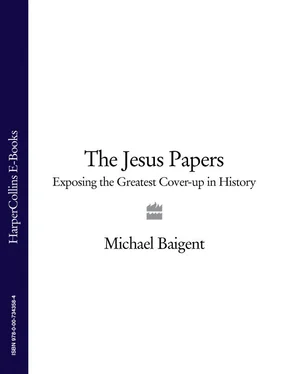There was another visitor to Saint Sulpice in those provocative days of the early 1890s: the Abbé Saunière, the priest of Rennes le Château. The story—which has proved implacably resistant to verification—relates Saunière’s discovery of documents during the renovations of his church. After showing these documents to his bishop, he was ordered to travel to Paris, where a meeting with experts at the Seminary of Saint Sulpice was arranged. This occurred in or around 1891. Reportedly, Saunière stayed in Paris for three weeks. When he returned, he had access to considerable wealth, sufficient to construct a new road up the hill to the village, to renovate and repaint the church, and to build a comfortable and fashionable villa, an ornate garden, and a tower that served as his study.
Could Saunière’s documents have been those seen and translated by Canon Lilley? Could Saunière’s sudden wealth be due to his finding them? The Rev. Bartlett certainly thought so. And if this were true, then it would certainly explain a very curious image still on the wall of the church at Rennes le Château—an image that reveals something very heretical indeed about the beliefs of the Abbé Saunière.
Although the church at Rennes le Château is small, it is decorated inside like a Gothic fantasy, something more at home in a Bavarian castle for King Ludwig II than a Pyrenean hilltop village. It is bulging with images and color. Investigators have spent years trying to decipher the many clues Saunière embedded in the symbolism. But there is one image that is very clear—one image that does not take any great occult or symbolic knowledge to understand.
Like all Catholic churches, this one has, around its walls, plaster reliefs of the Stations of the Cross. They are a set sequence of images depicting the stages of Jesus’s walk along the road to Golgotha after his trial. They are used for contemplation and prayer, serving as a kind of map to the resurrection for the faithful. Those about the walls of the church at Rennes le Château are from a standard pattern of casts supplied by a company in Toulouse that can be found in a number of other churches. At least, the plaster-cast images are identical. They differ in one important respect, however: those at Rennes le Château are painted, and in a very curious manner indeed. One image, for example, shows a woman with a child standing beside Jesus; the child is wearing a Scottish tartan robe. Others are equally curious. But the most curious of all is Station 14. This is traditionally the last of the series illustrating Jesus being placed in the tomb prior to the resurrection. At Rennes le Château the image shows the tomb and, immediately in front of it, three figures carrying the body of Christ. But the painted background reveals the time as night. In the sky beyond the figures, the full moon has risen.
If the full moon has risen, it would mean that the Passover has begun. This is significant because no Jew would have handled a dead body after the beginning of the Passover, as this would have rendered him ritually unclean. This variation of the fourteenth station suggests two important points: that the body the figures are carrying is still alive, and that Jesus—or his substitute on the cross—has survived the crucifixion. Moreover, it suggests that the body is not being placed in the tomb, but rather, that it is being carried out , secretly, under the cover of night.
It is important to note that the Stations of the Cross at Rennes le Château were painted under the direct supervision of Abbé Saunière. He appears to be telling us that he knows—or at least believes—that Jesus survived the crucifixion. Could he have learned this on his visit to Saint Sulpice, we wondered? Did he meet there the same group of scholars who called Canon Lilley to Paris? If we accept the story as it has been relayed to us, then on the face of things the answer to both of these questions seems likely to be yes.
Whatever the answers—and we are hardly in a position to come to any definite conclusions just yet—Station 14 as it is depicted on the wall of this church serves as an eloquent testimony to a secret heretical knowledge that once lay in the hands of a priest in deepest rural France.
It seemed unreasonable for us to suppose that Saunière was alone in his belief. We thought surely there must be other clues in other churches, in documents, and in the writings of those who held the same convictions. Would finding them prove any validity to this story? We needed to know how the crucifixion could have been managed such that Jesus, or his substitute, might have survived. And we needed to know what this might mean. We thought it was time to look at the biblical accounts of the event from this fresh perspective.
The idea of a rigged crucifixion has been around a long time; even the Koran mentions it. 1 But just how could a fraudulent crucifixion have been arranged? According to the gospel accounts, everyone except Jesus’s disciples seemed to want him dead, or at the very least, well out of the way. The Jewish authorities and the vociferous mobs gathered in the street wanted to be rid of him, as did the Romans, albeit by default. According to the common interpretation of the gospel reports—which we have seen in countless films—Jesus was tried in public before “the Jews,” the crowds cried out that he should be crucified, Pilate washed his hands of the matter, Jesus then had to carry his own cross to the place of execution through crowds of bystanders who wished him ill, and finally, he was nailed to a cross between two thieves in a public place of execution called Golgotha—the “Place of the Skull.”
Had he tried to escape, either from the trial or the trek to Golgotha, it would have immediately been noticed. There would have been plenty of volunteers who’d have quickly pushed him back onto his road of execution. The Gospels inform us that the Romans had abdicated all responsibility for him; they no longer cared what happened.
JUDAEA, JESUS, AND CHRISTIANITY
| Before 4 B.C. |
Birth of Jesus, according to Matthew’s Gospel (2:1). |
| 4 B.C. |
Death of Herod the Great. |
| A.D. 6 |
Birth of Jesus, according to Luke’s Gospel (2:1-7). Census of Quirinius, Governor of Syria. |
| A.D. 27-28 |
Baptism of Jesus (traditional date) in the fifteenth year of the reign of Emperor Tiberius (Luke 3:1-23). |
| A.D. 30 |
Crucifixion of Jesus, according to Catholic scholarship. |
| c. A.D. 35 |
Following the marriage of Herod Antipas and Herodias in c. A.D. 34, John the Baptist is executed, following the evidence in Josephus. |
| A.D. 36 |
Passover—crucifixion of Jesus, according to Matthew’s timetable. |
| A.D. 36-37 |
Conversion of Paul on the road to Damascus. |
| c. A.D. 44 |
Execution of James, the brother of Jesus. |
| A.D. 50-52 |
Paul in Corinth. Writes his first letter (to the Thessalonians). |
| A.D. 61 |
Paul in Rome under house arrest. |
| c. A.D. 65 |
Paul supposedly executed. |
| A.D. 66-73 |
War in Judaea. The Roman army under Vespasian invades Judaea. |
| c. A.D. 55-120 |
Life of Tacitus, Roman historian and senator, who mentions Christ. |
| c. A.D. 61-114 |
Life of Pliny the Younger, who mentions Christ. |
| c. A.D. 115 |
Ignatius, Bishop of Antioch, quotes from letters of Paul. |
| c. A.D. 117-138 |
Suetonius, Roman historian, mentions “Chrestus.” |
| c. A.D. 125 |
Earliest known example of a Christian gospel, John 18: 31-33, Rylands Papyrus, found in Egypt. |
| c. A.D. 200 |
Oldest known fragment of Paul’s letters, Chester Beatty Papyrus, found in Egypt. |
| c.A.D. 200 |
Oldest virtually complete gospel (John’s), Bodmer Papyrus, found in Egypt. |
| A.D. 325 |
Council of Nicaea is convened by the Roman emperor Constantine. The divinity of Jesus is made official dogma by a vote of 217 to 3. |
| A.D. 393-397 |
Council of Hippo, formalizing the New Testament, is finalized at Council of Carthage. |
THE MACCABEES AND HEROD
Читать дальше












